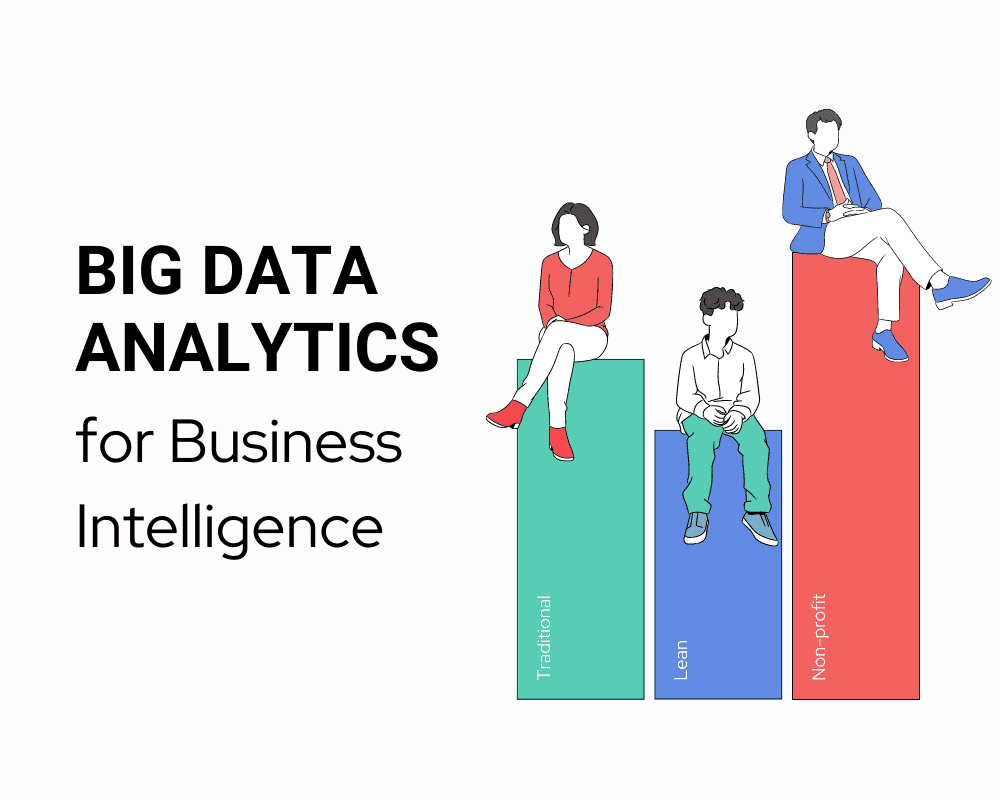Big Data Analytics: Why Is It So Crucial For Business Intelligence?
Understand the relationship between big data and business intelligence.

Image by Editor
People often misunderstand the relationship between big data and business intelligence. In most instances, your business intelligence solution already uses big data analytics in some capacity. If it’s not, then that’s a huge blindspot you must address.
But why is big data analytics so crucial for modern businesses? Why should you utilize it as part of your business intelligence processes or stacks? This guide will answer these two questions and more. But first, let’s look at what these terms mean so you can better understand how and where they fit together.
What Is Big Data Analytics?
As more companies and industries have begun to embrace technology, digital transformation spending is set to reach $3.4 trillion by 2026. We’ve seen a growing reliance on technology, and no industry is exempt from this change. For example, according to a recent study conducted by GetWeave, 98% of healthcare providers agree that technology plays a crucial role in providing a superior experience for customers.
All this technological and digital transformation has opened new avenues for data gathering. As of 2023, at least 3,5 quintillion bytes of daily data are generated globally. This large storage of raw collected data is referred to as big data.
Not all this data is useful to businesses, and often, it is too voluminous to be handled by traditional data processing software. Before most big data can be used in meaningful ways, it must be sorted, filtered and even labeled. These processes make up an important part of big data analytics.
Some of the most used types of technology and tools for big data include:
- Data storage and processing (Hadoop)
- Data provisioning and distribution (Cassandra)
- Stream analytics tools
- Predictive analytics software
- Data lakes
- Knowledge discovery
- Data mining tools
- In-memory data fabric solutions
- Data virtualization
- Data cleansing
- Cluster computing frameworks
As you’ll see, many of these tools are utilized in business intelligence too.
What Is Business Intelligence?
Business intelligence (BI) describes the process of using technology to extract actionable insights from business data. These insights are then visualized and presented to company executives, allowing them to make informed decisions based on empirical data.
Business intelligence is often confused with business analytics and may also be why big data analytics is conflated and mistaken with BI. But while business intelligence seeks to gain present-day success by using old and new data, business analytics looks at the links between present and past data to predict future data (the future of the business).
Both approaches can use big data analytics to achieve their goals, but let’s focus on business intelligence. It revolves around a litany of analytics processes and solutions such as (but not limited to):
- Data mining
- Predictive analysis
- Statistical analysis
- Big data analysis
- Data visualization software
- Key performance indicators (KPI)
- Performance benchmarking software
- Querying software
- Real-time analytics software
By implementing an effective BI strategy, companies can enhance their abilities to access and use key data. Ultimately, BI can increase your company’s overall profitability by ensuring that all business decisions are enriched with factual data. It can also help companies improve their internal processes, which allows them to run more optimally.
You can use business intelligence to uncover market trends, discover new revenue streams, and identify overlooked business problems. Big data analytics can be a fundamental part of your organization’s BI strategies.

Photo by Pexels
Big Data Analytics Use Cases for Business Intelligence
Big data analytics can be used as part of your business intelligence strategy in the following ways:
Product Development and Improvement
New product development describes the life cycle of a product, from its inception to marketing. How you approach product development will depend on the model you use. For instance, data analysis is the first step in Roozenburg & Eekels’ simple 3-phase New Product Design (NPD) model.
Regardless of your chosen model, the foundational steps will require you to perform stringent research. This applies to making product improvements or introducing existing product variations.
Today, most corporations have global aspirations, as it presents them with more financial opportunities and incentives. However, it requires more intense market research, including data acquired from surveys, website tracking data (cookies), credit report statistics, etc.
Consumer attitudes and needs are ever-evolving, and some needs may be seasonal. Thus, your data pools will grow and be updated constantly, essentially becoming big data. You need a big data analytics system that can sort, process and find patterns at nearly the same velocity that the data is being generated.
Business intelligence software can be used to deliver all patterns and statistics in a more manageable way. Organizations can then use this data to develop proposals, blueprints and plans for new product designs and improvements. They can also use this information to determine their operations and material requirements and make more precise development cost estimations.
Price Optimization
Companies can price their products more accurately if they can calculate the development cost in the early stages; this goes for established products too.
Your big data should contain patterns indicating the connection between the current global economic climate and shopping trends. For instance, to remain competitive during 2022 and 2023, companies began to reduce the total units and mass they included in a packaged product. For example, a 500g bag of potato chips would be reduced to 450g and sold for the same price. This is called shrinkflation.

Photo by Brett Jordan
Big data analytics paired with business intelligence can help companies determine whether it would be more fruitful to increase prices or make up for growing costs in other ways. Furthermore, it will also help you determine if a current line of products is worth shelving.
Streaming and TV production can benefit from big data analytics as well. By combining information from the current zeitgeist, streaming behaviors, and polls, these companies can make more effective decisions in deciding which shows to cancel and which to keep.
For instance, we’ve seen entire swaths of Netflix subscribers drop the streaming giant because a certain show was canceled. A study conducted by Parrot Analytics found that Young Justice was one of the most in-demand series of 2023. Yet, HBO Max canceled it in late 2022.
What this tells us is that many of these decisions weren’t fully informed. Big data analytics and business intelligence can stop your company from making the same mistake.
Supply Chain Management

Created by fatmawatilauda70555
2021 and 2022 saw huge supply chain interruptions, and it’s one of the many factors fueling current inflation. Many retailers use a just-in-time inventory management solution, but while it can be efficient, it has little protection against supply chain interruptions.
Big data analytics and business intelligence can help companies deploy more agile inventory and supply chain management. They can provide real-time data that can then be interpreted by a machine learning-driven BI solution to deliver predictive analytics.
This can help companies protect themselves from supply chain interruptions, as this supply chain data isn’t limited to available raw materials or manufacturing capacity. It also considers the weather, shipping delays caused by natural disasters, shopping trends, pricing, the economic climate, etc.
You can also use this information to reduce stock and avoid wastage when demand decreases. Thus, it can make your JIT inventory management system more optimal.
Channel Analytics
We’ve covered how big data analytics and BI can combine information from various channels to help enterprises improve their new product design and development, price optimization, and supply chain management.
But how do you determine the quality of each channel and the integrity of its information? There are various channels, and they’re not all restricted to web channels. Other channels may include customer support calls, postage mail, store or branch locations, etc.
Enterprises can use big data analytics and business intelligence for channel discovery. They can also reveal the integrity, quality, and efficiency of channels and how well they integrate into their systems. Ultimately, you can think of it as big metadata as it’s data about your big data. By affirming the channels you gather your data from, you’re essentially affirming the quality of your big data.
Conclusion
The big data analytics market is estimated to reach over $650 billion by 2029. This is hardly a surprise, as this guide has shown the many ways big data analytics can be used to enrich business intelligence. More firms should aspire to become data-first enterprises, and with companies such as Datapine providing business intelligence solutions with big data analytics, it should be easier than ever.
Nahla Davies is a software developer and tech writer. Before devoting her work full time to technical writing, she managed — among other intriguing things — to serve as a lead programmer at an Inc. 5,000 experiential branding organization whose clients include Samsung, Time Warner, Netflix, and Sony.
